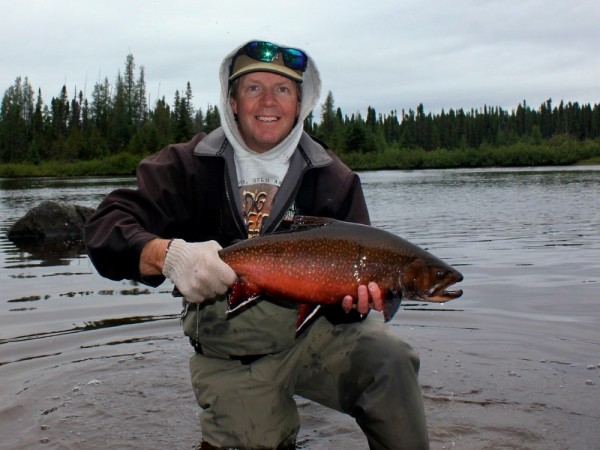
Doesn't get much better than this! A monster brookie from Canada. Photo courtesy Mike Sadar.
Click to view image


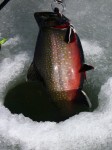
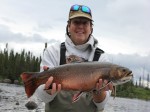

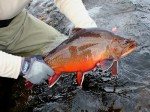


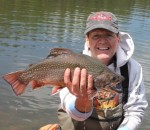
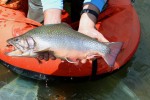

The brook trout, actually a char, is scattered throughout the North and South American continents and to land a monster will be on most serious anglers lists. Those of us who have relentlessly searched for trophy brook trout have learned that a true trophy is a specimen that exceeds the 3-pound barrier in the lower forty-eight. In these waters, a five-pound fish is a very rare trophy that may be a single lifetime event in a trophy brook trout hunterís life.
More than anything, the brook troutís genetic makeup prevents its growth to these trophy sizes. In waters that are small and void of food, the brook trout can genetically proliferate more than any other trout species and ultimately dominate the environment in numbers. But the price they pay is very limited growth. These small stream brook trout rarely exceed 8-inches and a fish over 10-inches is exceedingly rare. For a brook trout to grow bigger, they must be in waters that are incredibly fertile that allows for year round growth. In these waters, which need to be hidden from the pressure of humans, will allow them to grow at much faster rates. In this environment, the brook trout pays a different price with rapid metabolism and thus a shortened life span. Here, the biggest big brook trout may reach that 3-5 pound mark in a lifespan of only 2-3 years. These fish often fail to spawn effectively and its population will be held in check, allowing plenty of food to grow.
It is often the case when these sacred waters found, they are nearly always decimated, as most just do not understand the complex ecosystem necessary to produce a trophy brook trout. If the waters are managed as trophy waters, they can become perennial waters for trophy brook trout. Like all trout, brook trout can become very resistant to fishing pressure and be one of the hardest of all species of trout to catch. These are usually those waters that will produce a trophy brook trout once in a great while.
The brook trout is cursed. It has the genetic implant to procreate at the expense of growth, or to grow exceedingly fast at the expense of a shortened life. Throw in its incredible fragility to fishing pressure and the chances of them reaching trophy sizes decreases significantly. Thus, the chance of a brook trout exceeding 5 pounds is rare in the majority of waters across the globe, but there are always exceptions.
There are a few scared waters scattered throughout the lower 48, and most are local secret little places that are hard to get to. These waters may be good for a few years and then die off for a few years until the stocks become replenished. The majority of these waters can produce those trophies up to about 5 pounds, but even here, catching a brook trout that exceeds 6-pounds is exceedingly rare. In fact, a 6 or 7 pound brook trout may be an equivalent size to a 25-pound brown in the west, or 50-pound lake trout by comparison. The point is the waters and the trophy brook trout that they hold are very hard to come by.
All rules have exceptions and these are those rare events when a brook trout over 5 pounds are caught. In these cases it is synonymous to meeting up with that 7-foot human or winning the lottery. Another common occurrence is splake. A splake is a hybrid trout that results when a female lake trout and male brook trout successfully breed, which often occurs in nature. These offspring can mistakenly be identified as a brook trout. If the splake is a first generation cross, in that its immediate parents are a brook and a lake trout, the dominant characteristics favor that of a brook trout. Only subtle differences between a brook trout and a splake can be noted and it often takes an ichthyologist or DNA analysis to distinguish between the species.
So where does one find those true giant brook trout? The answer is simple. Go North and go East! Eastern Canada, without exception is the natural range of the biggest brook trout in the world, and year after year, specimens exceeding seven pounds are landed, including a few that fall into the 8, 9 or 10 pound class! For these biggest fish there are a few select waters that are capable of producing behemoth brook trout. For those who are inclined to travel, here is the short list of waters
Osprey Lake Labrador
Fortress Lake, Alberta
Godís River, Manitoba
Sutton River, Ontario
Minipi River, Labrador
In my quest for a true monster brook trout, I have researched these waters and have been fortunate to visit Fortress Lake, Gods River, Sutton River, and the Minipi River. I have landed some good brook trout in all these places, along with the exceptional brook trout that exceeded 5-pounds. Each of these places were spectacular in their own way, mostly due to high numbers of fish landed in the 2-4 pound range.
However, there has only been one water where I have landed many brook trout in excess of seven pounds. That is the Minipi River. In fact, this water has been so good, I have returned fish a total of ten times without disappointment! As for size and numbers, the rule is quality over quantity.
I visited most of these other waters prior to my first trip to Minipi. During those trips, I asked each of the camp managers one question: aside from your camp, if you could go anywhere for a trophy brook trout, where would you go? Hoping for an honest answer, every manager answered the same Ė the Minipi River. These responses to a common water was enough information for me to my pennies for a trip to this famous fishery.
My first trip to Minipi was back in 2000 and I had a lofty goal to hold and admire a 7-pound brook trout. The first morning of fishing began with dark skies and heavy drizzle, which was ignored as I cast different streamer flies into the inlet of a small pond. After a dozen casts, I had a hard strike and hookup. After several tense minutes I landed my fist Minipi brook trout. It was a beast of just over 7-pounds. That trip yielded me thirty trophy brook trout with four over 7 pounds and another dozen over 6. My biggest was an 8-pound male! I now understood why this water was so famous for its resident brook trout!
So why do these brook trout grow so big? There is some fundamental science that forms my theory as to why Minipi Brook trout grow to such phenomenal size. It is based on three keys, which are usually the link to trophy trout around the globe. These are genetics of the fish, the fertility of their environment, and the impact of human pressure.
The Minipi River system is actually a chain of lakes that are linked to each other by short stretches of faster moving water. The lakes are shallow and located in an ideal latitude that yields an incredible forage base. This forage base includes leaches, shrimp, gigantic hatches of drakes, caddis, and mayflies. Late in the year, their diet also includes a heavy dose of mice. This combination of food allows these fish to grow between a half to a full pound over the summer months.
The genetics of the Minipi brook trout is the second key to this puzzle. Recent DNA studies show that these brook trout are most closely linked to brook trout from northern Labrador. However, these northern brook trout do not grow huge because of the much shorter summer growing season and the fact they are found in waters that are far less fertile than Minipi. But what these fish do possess is longevity. These northern brook trout can live up to a dozen or more years, and this longevity has proven to be the key to Minipiís brook trout growing so large. Tagging studies have shown that Minipiís brook trout do grow rapidly, but not at a rate where their metabolism shortens their lifespan.
The final piece to the Minipi puzzle is human predation. Since its discovery in the 1950ís, the Minipi River has been managed as a catch and release fishery. This catch and release policy has stabilized the gene pool for these fish and allows the strongest and largest fish to breed to yield the strongest and biggest offspring. Do this for hundreds of generations and the gene pool has been perfected!
The combination of available feed, genetics, and virtually no human predation on the Minipi fishery has yielded the perfect storm for the worldís largest brook trout. In 9 of the 10 years I have fished this water, I have landed at least one brook trout that exceeded the 7-pound barrier and on 6 of those trips I have landed brook trout in excess of 8-pounds. Year in and year out, this watershed consistently produces the biggest brook trout in the world!
One of the tradeoffs with Minipi versus the other trophy Canadian brook trout waters is that numbers are traded for size. A good week at Minipi would be twenty trophy brook trout, where other waters might yield a hundred trophy fish. The difference is the size of the trophy, which is bigger in Minipi than anywhere else.
Minipi has taught me some very good lessons that have proven valuable for fishing those sacred trophy brook trout waters back at home. The first is that brook trout are very sensitive to pressure and spook very easily. If one can be careful not to spook the fish, the fishing will typically remain good until they sense the presence of a predator (i.e. a fisherman) and then they will become tightlipped! Second, brook trout shy away from light. The best fishing is under low light conditions, which provides camouflage for the fisherman. The best fishing is very early in the morning or late in the evenings and best at night. Yes, brook trout can be nocturnal in highly pressured waters. During the middle of the day, fishing slows to the extent that a siesta is not a bad idea.
When fishing times of low light, my favorite approach is to fly-fish mouse patterns. These are effectively fished with fly rod, but I have also had success casting poppers or even small jitterbugs. These lures are fished very slowly with many starts and stops, and when a brook trout decides to take the lure, hold on tight!
Other favorite fly patterns include big leaches. My favorite streamer patterns include a black and peacock wooly bugger, black bunny leaches, red and white marabou, and flies that are red with silver. Depending on the weather, dry flies also can produce enormous fish. Small dark caddis flies are a favorite pattern as well. Another super technique is to fish a small black or olive jig close to the bottom. I often fish these off a fly rod, and try to keep them within a foot or less of the bottom at all times. Brook trout love heavy rocky structure, and it is common to donate many jigs over the course of a trip. But that is the price to pay for the monsters in this river!
If planning a trip to Minipi, timing is always a consideration. For this system, fishing is consistent throughout the summer. June brings active fish that are typically aggressive, but it also has the most unpredictable weather. July is popular for dry fly diehards as there are mega drake hatches that attract the biggest brook trout to come up from the depths in search of these delicacies.
August is my favorite time for big brook trout, whether it is on the Minipi River or some special little lake in Colorado. As fall approaches these fish change to their spawn colors and are transformed into the most beautiful of all species of trout. They are also the heaviest of the year and exhibit aggressive traits as they approach their spawn. They also tend to key on mouse patterns, which is one of the most exciting aspects of fishing. To see a brook trout in excess of 7-pound vault out of the water and crush a mouse is an experience that is never forgotten! Weather is less predictable in the late season, so prepare for the elements and for big brook trout!
I have been hunting giant brook trout since I was a youngster and have come across a few very good waters. The ability to research and venture to a new water that is suspected of holding big brook trout, is similar to the prospector looking for the next gold vein. When searching waters close to home, look for small lakes with high levels of feed (lots of weeds), primarily in the form of freshwater shrimp, waterdogs, and leeches. Normally these waters are void of high numbers of other trout species and the overall numbers of big brook trout are low. Those waters that are difficult to reach and especially those that require long hikes are the best candidates to find trophy brook trout.
Once a lake is found, focus on rocky structure, such as rockslides, channels and areas where there are springs. The ideal location will be a rocky bottom near an inlet or spring. This provides cooler water and higher oxygen levels, key ingredients for big fish.
And for the biggest of all brook trout, the Minipi River is the one place I have found that consistently places the odds in my favor to catch a 7-pound plus monster. It does require more planning and effort to get there from both a financial and planning perspective, but visiting this watershed is a worthy goal for any serious brook trout angler. If you visit this water, beware - you will want to return again and again!
Mike Sadar